








 Français
Français
Understanding > Fundamental concepts > Phenomena IX
RISING AND SETTING OF STARS
HELIACAL RISING
The problem of the rising and setting of the stars is particularly insofar as the equatorial coordinates stars can be considered as fixed if we neglect the precession of the equinoxes and the proper motion of the stars, that is possible for short periods of time. The stars will therefore move during the Earth diurnal motion on small circles having the North celestial pole as pole, that is to say small circles parallel to the Earth equator. The planets, the Sun and the Moon have not fixed equatorial coordinates and so, will not move exactly on these small circles.
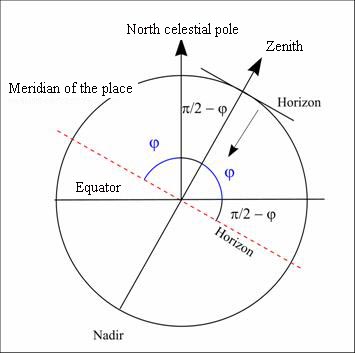
On figure 1 we show a meridian cut of the celestial sphere, the Earth equator and the direction of poles, and for a point of the terrestrial sphere, having latitude j, we plotted the horizontal plane to the sphere on this point and the direction of zenith. The opposed direction to zenith is named nadir. If we transpose the observing place to the centre of the Earth and if we make a rotation of the figure of ρ/2 - j in order to make horizontal the horizon of the place, we obtain figure 2. The circle represents the local meridian of the place.
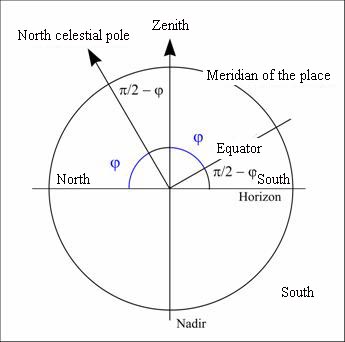
On this figure one sees that the angle between the direction of the pole and the direction of the horizon is equal to the latitude of the place. The angle between the direction of the zenith and the direction of the pole is equal to the complementary of the latitude i.e. to the colatitude φ. Similarly, the height of the equateur above the horizon is equal to the colatitude of the place.
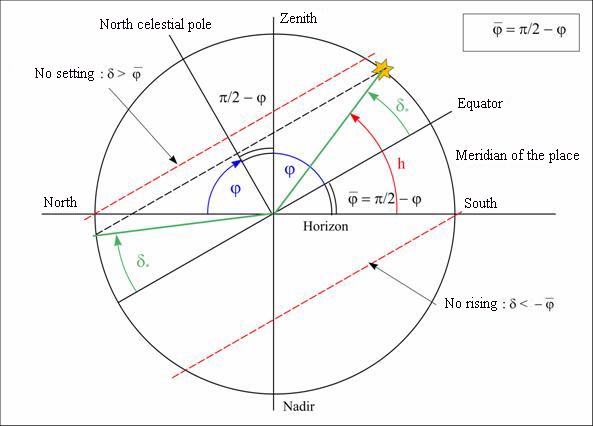
Let's put a star having the declination d* at its superior meridian transit. A star having a declinaison d* (let's remind that the declination is the height of the star above the equator) has, at its superior meridian transit, a height hSup equal to the sum of its declination and of the colatitude of the place.

Projecting the apparent path of the star (small circle normal to the line of poles) during a rotation of the Earth around its axis is a line parallel to the equator.
Similarly, it is easy to see that the height of the star at its inferiro meridian transit, is equal to its declination minus the colatitudeof the place.

It is then easy to determinate for a given place what will be the stars which have rising and those which have no rising and no setting. These last stars are named circumpolar.
| stars which have |
Conditions | Results |
|---|---|---|
never rising |
hsup < 0 |
δ* < -φ |
never rising and setting |
hsup > 0 et hInf < 0 |
-φ < δ* < φ |
never setting |
hInf > 0 |
δ* > -φ |
We find that the more you go up in latitude, the less we see stars. Thus from the pole we see only half of the stars, those of the northern hemisphere from the North pole and those of the southern one from the South Pole. When you are on the equator, you have the opportunity to observe during the all year, all stars of the celestial sphere; in this case the stars near the poles are close to the horizon and there is no of circumpolar stars.
For a given star, its equatorial coordinates are fixed, azimuths at sunrise and sunset are almost always the same all along the year as the height at its meridian transit. These quantities vary slowly due to the precession of the equinoxes and the proper motion of the stars.
The heliacal rising of a star
All observable stars from a given place may rise and set every day, but they are not visible if the Sun is above the horizon. The period of visibility of a star depends on the apparent position of the Sun on the ecliptic. Below are some definitions of risings and settings of stars compared to sunrises and sunsets.
In the following definitions the word true indicates a real phenomenon (rising or setting), real but not observable, whereas the word apparent indicates a phenomenon real and observable. These definitions are those published by Delambre in his history of astronomy, there are sometimes different definitions including those of achronic rising and cosmic setting.
True phenomena :
The cosmic rising or true morning rising : day when the star rises in the morning at the same time as the Sun.
The cosmic setting or true evening setting : day when the star sets in the evening at the same time as the Sun.
The achronic rising or true evening rising : day when the star rises in the evening at the same time as the Sun sets West.
The achronic setting or true morning setting : day when the star sets West in the morning at the same time as the Sun rises East.
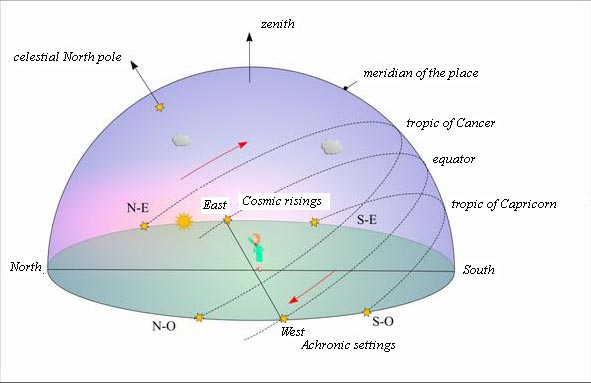
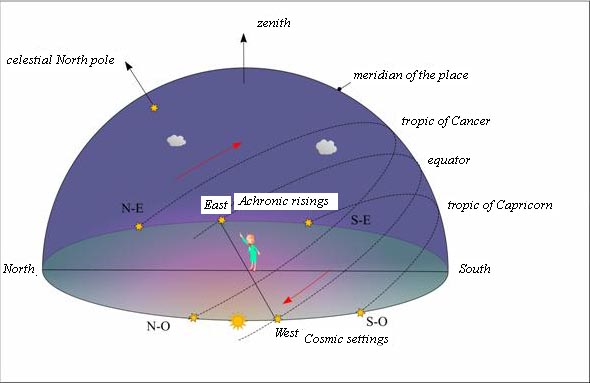
Apparent phenomena :
The morning heliacal rising or apparent morning rising: the first day when the star is visible to the east in the light of dawn just before sunrise. It is the beginning of the period of morning visibility.
The evening heliacal setting or apparent evening setting: the last day when the star is visible to the west in the twilight just after sunset. It is the end of the period of evening visibility.
The evening heliacal rising or apparent evening rising: the first day when the star is visible to the east opposite from the twilight just after sunset. This is the beginning of the period evening visibility.
The morning heliacal setting or apparent morning setting: the last day when the star is visible to the west opposite the light of dawn just before sunrise. It is the end of the period of morning visibility.
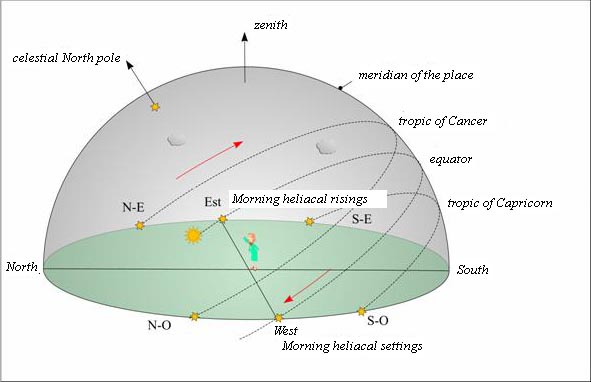
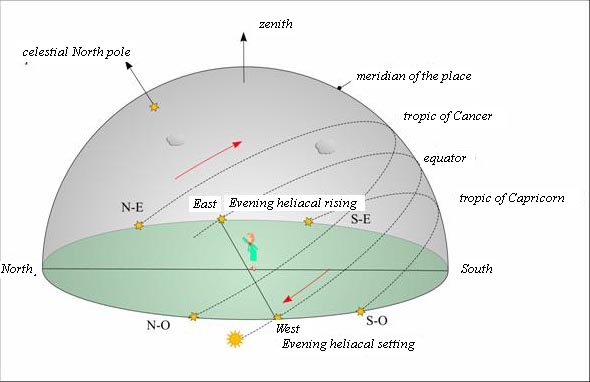
| Phenomena |
Visibility | Name | Name of the instant | |
|---|---|---|---|---|
| Rising | matutinal | true | cosmic | anatole |
| apparent | heliacal | epitole | ||
| vesper | true | achronic | ||
| apparent | heliacal | |||
| Setting | matutinal | true | achronic | dyse |
| apparent | heliaque | |||
| vesper | true | cosmic | ||
| apparent | heliacal | crypse |
The terms anatole, epitole, dyse and crypse are no more used nowadays; below the definitions given by Delambre in his "Histoire de l'Astronomie Ancienne".
« The anatole takes place when the star appears at the horizon just rising;; the epitole is the apparition of the star on the horizon when the Sun is rolling away from the star. The dyse or simple setting refers to the horizon ; the crypse refers to the Sun approaching the star and blooming it in its light. »
In the solar calendars, the dates of the heliacal, cosmic and achronic risings and settings of the stars move slightly because of the precession of the equinoxes.
History :
The study of the first and last visibilities of the stars is performed since the highest antiquity. The moving sphere and the risings and settings of stars are the oldest astronomical treatises coming from the Greeks, they are the work of Autolycus Pitane (near 330 before J.C.).
These two books are the first of a collection that Greek historians name « Early astronomy », as opposed to the « Great Mathematical Syntax (the Almagest) » from Claude Ptolemy (middle of the second century).
Early astronomy includes the following items which are later to treaties by Autolycus:
The Phenomena by Euclid,
About magnitudes and distances of the Sun and the Moon by Aristarchus of Samos
On the Ascensions by Hypsicles,
Spherical - On days and nights - On habitations by Theodosius.
During antiquity, the Greek astronomers produced parapegmes, kinds of almanachs giving the dates of the heliacal risings and settings of the main stars in their lunar calendar. The heliacal risings and settings are related to the Sun, so to the solar calendars and to seasons and to the knowledge of the dates. The observation of these phenomena allowed to recognize the arrival of the different seasons as Hesiod : « At the rising of Pleiades, Atlas' daughters, start harvesting, and at their setting, start to plow. »
access to the calculation of the heliacal risings of Sirius
Credit : P. Rocher, IMCCE/observatoire de Paris